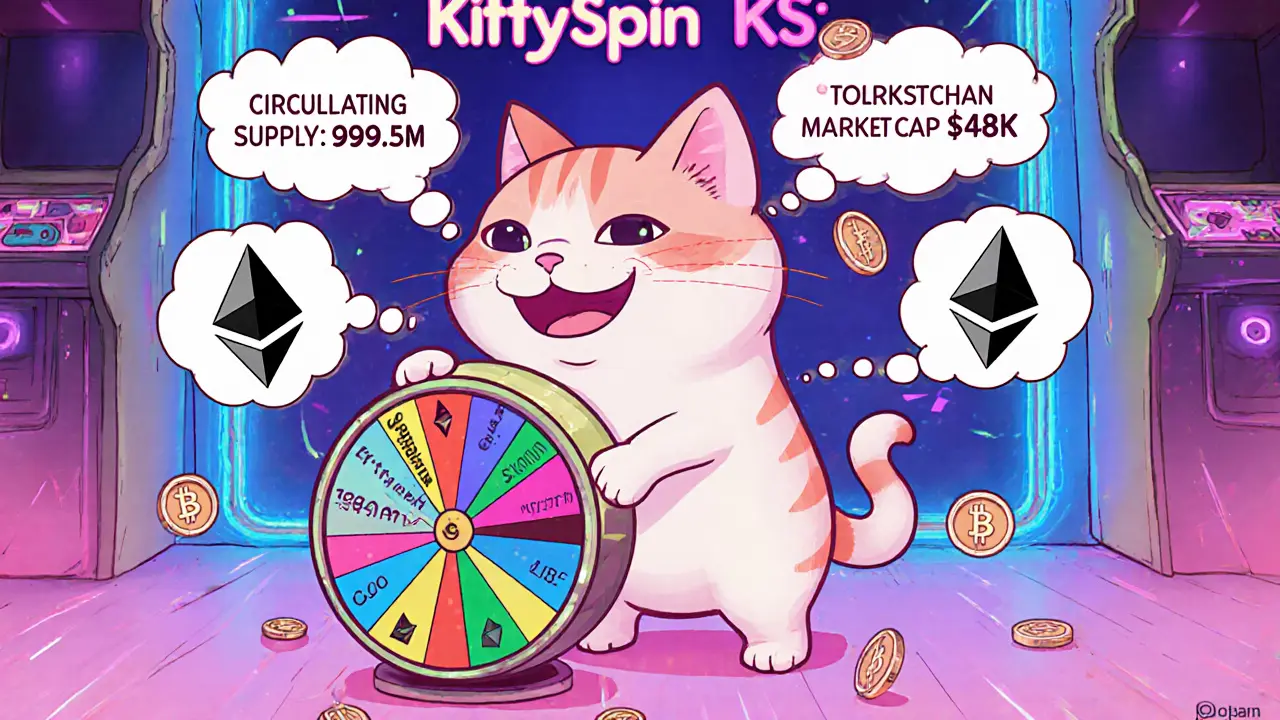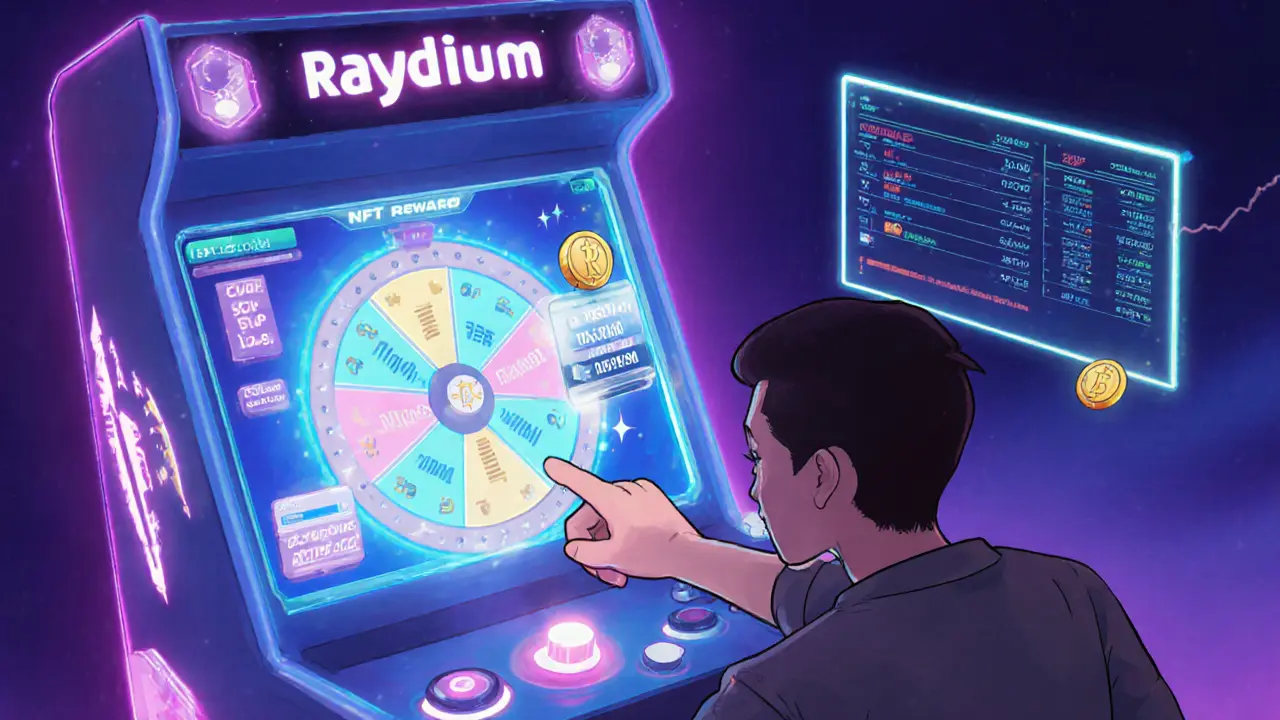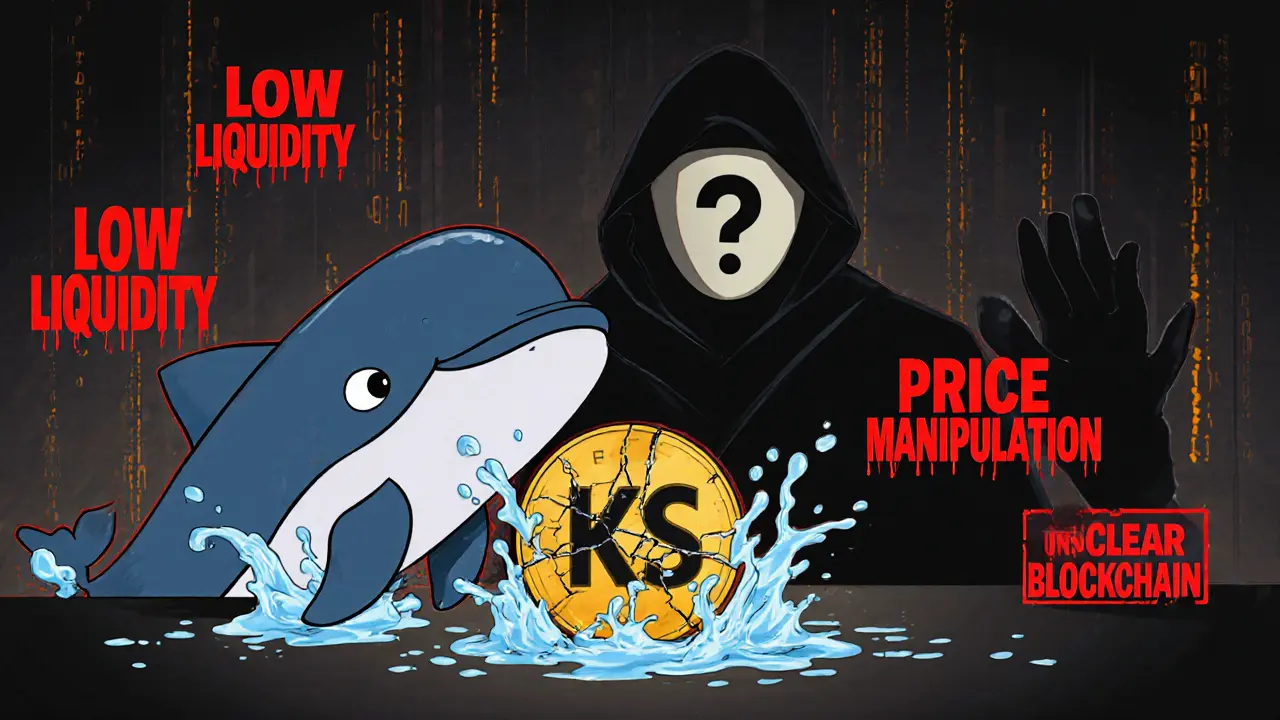
KS Token Liquidity Risk Calculator
The KittySpin (KS) token has extremely low liquidity with daily trading volume under $1,000. This tool estimates potential slippage when buying or selling KS tokens based on current market conditions.
Current market data: Market cap $48K, Daily volume $600-$150 (Raydium), Circulating supply 999.5M KS.
Enter your trade details to see estimated slippage and transaction costs.
Key Takeaways
- KittySpin (KS) is a micro‑cap play‑to‑earn token launched in 2018.
- It claims to run on Solana, though some sources list Ethereum as its base.
- Circulating supply is about 999.5million KS with a market cap around $48K.
- Liquidity is extremely low; most trade happens on Raydium (KS/SOL pair).
- Risks include unclear blockchain, scarce development updates, and high price‑manipulation potential.
What is KittySpin (KS) Token?
KittySpin (KS) is marketed as a play‑to‑earn cryptocurrency that powers an arcade‑style gaming platform. The token is meant to be used for in‑game purchases, reward payouts, and trading within the ecosystem.
KittySpin is a blockchain‑based token designed for a play‑to‑earn arcade gaming environment. The project’s team, which remains largely anonymous, says the goal is to let players earn KS while they spin virtual wheels, complete mini‑games, and collect NFTs.
Underlying Blockchain: Solana vs Ethereum
The official narrative points to Solana as the host chain because of its high throughput and low fees, which are essential for fast game interactions. However, several market‑data aggregators still list the token on Ethereum, creating confusion for anyone trying to verify contract addresses.
Solana is a high‑performance layer‑1 blockchain known for sub‑second transaction finality and cheap fees suits arcade‑style games, while Ethereum is the most widely adopted smart‑contract platform, offering robust security and a massive developer community provides broader wallet compatibility. The mixed signals make it hard to know which network actually processes KS transactions.

Tokenomics: Supply, Price, and Market Data
As of October2025, KittySpin has a total supply of 999,497,741.631167 KS, with roughly 999.5million already circulating. Prices differ across exchanges:
- MEXC: $0.00004852, market cap $48,500.
- CoinGecko: $0.00002871, 24‑h volume $4.86.
- CoinMarketCap: $0.00002995, no reported volume.
- LiveCoinWatch: $0.000037, up 1.03% in 24h.
The token’s all‑time high was $0.00351908, meaning current prices are about 98% below the peak.
How the Play‑to‑Earn Model Works
Players log into the KittySpin arcade, spin virtual wheels, and complete short challenges. Successful actions generate KS tokens that are automatically sent to the player’s wallet. The platform also promises NFT drops that can be traded or used to unlock special game modes.
In theory, the flow is simple:
- Deposit a small amount of SOL (or ETH, depending on the chain) to cover transaction fees.
- Play a game - each spin costs a fraction of a KS token.
- Win KS or a random NFT, which appears in the user’s inventory.
- Withdraw earned KS to a supported exchange or keep it for in‑game upgrades.
Liquidity and Trading Landscape
The primary market for KS is the Raydium decentralized exchange on Solana, where the KS/SOL pair accounts for 100% of reported DEX volume (about $604 in the last 24h). Centralized venues like MEXC, Bybit, and CoinGecko list the token, but their reported volumes range from under $5 to $150, hinting at stale order books.
Low liquidity leads to two practical problems:
- High slippage - even a tiny buy order can push the price up several percent.
- Price manipulation risk - a whale can move the market with a few thousand dollars.

Roadmap and Future Plans
The publicly posted roadmap highlights three upcoming milestones:
- Introduce new gameplay mechanics and a veteran‑mode leaderboard.
- Launch NFT integration that lets owners stake KS for bonus spins.
- Host community events with token‑backed prize pools.
Unfortunately, the roadmap lacks concrete dates or technical whitepapers. No public GitHub repo, developer forum, or audit report has been found, which makes it hard to verify whether these items are in active development.
Risks and Red Flags
Potential investors should weigh several warning signs:
- Liquidity crunch - daily volumes under $1,000 make exiting positions difficult.
- Conflicting blockchain claims - uncertainty about whether KS lives on Solana or Ethereum.
- Scarce community activity - Reddit, Discord, and other social channels show minimal chatter.
- Lack of transparent developers - no identifiable team, no audit, no open‑source code.
- Micro‑cap status - market cap around $48K places KS among the most vulnerable tokens to pump‑and‑dump schemes.
While price‑prediction tools suggest a 150‑230% upside, those models ignore the fundamental issues listed above.
Comparison with Major Play‑to‑Earn Tokens
| Token | Blockchain | Market Cap (USD) | Daily Volume (USD) | Active Users (approx.) | Launch Year |
|---|---|---|---|---|---|
| KittySpin (KS) | Solana / Ethereum (mixed) | $48K | $600 - $150 | ~200 | 2018 |
| Axie Infinity (AXS) | Ethereum | $1.2B | $12M | ~800K | 2018 |
| The Sandbox (SAND) | Ethereum | $1.0B | $9M | ~350K | 2020 |
| Decentraland (MANA) | Ethereum | $850M | $8M | ~500K | 2020 |
| Gala Games (GALA) | Ethereum / Polygon | $320M | $5M | ~250K | 2020 |
The table makes clear why KS is a niche player. Its market cap is three orders of magnitude smaller, and daily trading activity is negligible compared with the major platforms that already have established game titles and large player bases.
Frequently Asked Questions
What blockchain does KittySpin actually run on?
Public data shows both Solana and Ethereum listings, but the official website mentions Solana as the primary chain. Until the contract address is verified on a single explorer, the exact blockchain remains unclear.
How can I buy KS tokens?
The most liquid market is the KS/SOL pair on Raydium. You can also find KS on centralized exchanges like MEXC, though order books are thin. Always double‑check the token contract before depositing funds.
Is KittySpin a meme token or a functional gaming token?
Tracking sites label it as a meme token, reflecting limited development activity and low community engagement. The platform’s intended use is gaming, but real‑world usage is minimal.
Can I earn real money by playing KittySpin games?
In theory, yes - you earn KS tokens that can be sold on Raydium. In practice, low liquidity means converting those tokens to fiat may cost more in fees and slippage than you earn.
What are the biggest risks of investing in KS?
Key risks include extremely low trading volume, ambiguous blockchain choice, lack of transparent development, and potential price manipulation due to its micro‑cap status.


Comments
Leynda Jeane Erwin
So, let’s get straight to the point: KS suffers from an almost negligible liquidity pool, which means any decent-sized order will move the price dramatically. The daily volume hovering under $1,000 is a clear warning sign. Even if the token lives on Solana, the thin order books on Raydium make slippage inevitable. Users should be prepared for a potential 5% price impact on modest trades, as the built‑in risk calculator already flags. In short, treat KS as a high‑risk speculative asset rather than a stable play‑to‑earn investment.